
Validation of Exceptional Longevity
 |
Validation of Exceptional Longevity Centenarian Validation in Belgiumby M. Poulain, D. Chambre, and M. Foulon |
[ References ]
According to Van den Eynden (1884) the first centenarian reported in Belgium was Antonus Hasechus, priest in Liège who lived until 125 years of age and died in 1584 (Figure 1). In the list of centenarians compiled by Van den Eynden several extremely aged centenarians are reported as presented in Figure 2. The oldest one was Maria Nausenne, who was born in 1630 and died in Dinant at the age of 125 years 11 months and 6 days. However, as illustrated by the following case, early extreme longevity is very difficult to validate.
| Figure 1. Antonus Hasechus, priest in Liège who lived until 125 years and died in 1584. |
 |
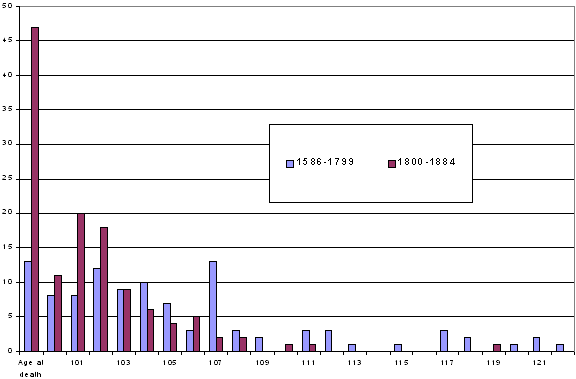 |
| Figure 2. Age distribution at death for all centenarians considered by Van den Eynden comparing two time periods and showing a clear age exaggeration in the Old Regime. |
According to Van den Eynden, Petrus Onghenae died in 1726 in Lokeren at the age of 112 years, 11 months and 14 days. As shown in Figure 3, a man named Peter Onghenae actually died in Lokeren on the 13th June 1726 in his 113th year of life. He was son of Laurentius and widower of Catherina Vermeire.
Looking back in the baptism register we found no Peter Onghenae born in 1613 but a Peter Onghenae, son of Laurentius and Algeburde Van Bruggen born in 1620 also in Lokeren. In the marriage register of the same parish we found a record of the marriage between Peter Onghenae and Catherina Vermeire in 1653 when he was 33 and she was 24 years old. They had four children born in 1654 (Laurentius), 1661 (Maria), 1665 (Joanna) and 1671 (Sara). She is supposed to have died at the age of 95. However, neither birth record nor death record relating to Catherina Vermeire has been found . We cannot exclude that a younger brother named after the above Peter Onghenae born in 1620 was the Peter Onghenae who married Catherina Vermeire in 1653 and died in Lokeren in 1726.
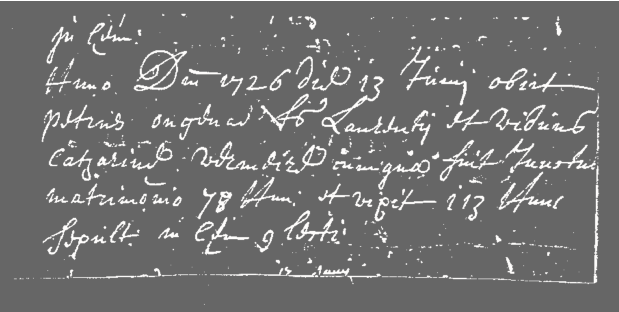 |
| Figure 3. The facsimile of the death record of Peter Onghenae who died in 1726 in his 113th year of life (Lokeren, death parish register). |
As we can see, the validation of these earliest super-centenarians is without comparison a heavy task and in most cases an unsolvable one. Nevertheless, if we look on the graph of Figure 1 in which all ages at death of centenarians reported by Van den Eynden are considered, age exaggeration is definitively suspected in most cases under the Old Regime while the situation seems to be better in the XIXth century. In the next points we will focus our approach on more recent centenarians with all potential data sources in order to try to achieve the exhaustive validation of all recent centenarians in Belgium.
The search for centenarians consists of two different tasks. First of all identification of all possible centenarians in a given population and secondly the validation of each of them as far as their age is concerned. The identification task is guided by the existence of information on the total number of centenarians living at one point in time or having died during a period of time. However, these statistical data are only numbers without precise identification of all centenarians. Therefore we will use these accounts in order to achieve the exhaustivity of the research taking into consideration that exhaustivity and validity of the data collection are both requested in order to study extreme longevity in a given population. Definitively, in this contribution, the objective of validation is closely linked to the one of exhaustivity. Validation of extreme cases of longevity is a very important task. Ensuring that we have identified and validated all centenarians among a given population is the only way to launch studies on a representative and significative base and to allow precise comparison between different populations in time or in space.
The Belgian data sources are among the best ones to ensure the validity and the exhaustivity of centenarian data. In order to demonstrate this point, we will consider all potential sources of information on centenarians in Belgium and illustrate each situation with different examples in order to make everything clear. Among the diverse data sources that will be presented, there are basically two broad categories:
There are also other ways to classify these data sources:
We shall consider successively all these potential sources of information on centenarians in order to check the reliability and the completeness of the data and the possibility to validate the exact age of all potential centenarians.
Census data are definitively one of the earliest possibilities to detect the existence of centenarians among a given population on an exhaustive basis. Therefore the census form must contain the age as a variable in order to compile the age structure of the population. If all ages are considered and more precisely ages over 100 years, we have the possibility to count the number of centenarians living in a specific country at the time of the census.
Following the French revolution, the newly-organised municipalities were obliged to keep « un état des habitants de leur ressort respectif contenant le nom, leurs prénoms, lieu de naissance, dernier domicile, profession, métier et autre moyen de subsistance (loi du 19-22 juillet 1791, titre 1, articles 1 et 2) ».(1) Since 1796, in Belgium as in France, some name lists of inhabitants with indications of age may be found in archives while statistical tables with age and sex structures are generally provided at department level. On this basis, French statistics in the first decade of the XIXth century are probably the first that give an account of the number of centenarians in Belgium.
These numbers of centenarians as well as the complete age structure are based on the list of inhabitants established by each municipality separately with the indication of age for each individual. As it was very difficult to update systematically these lists of inhabitants, censuses were organised systematically in order to renew these lists completely. Considering the statistical reliability of these first censuses, we may conclude that the ones in 1801 (an IX), 1804 (an XII) and 1806 have been seriously organised. However, it is clear that these data have to be treated with caution from a reliability point of view as there were probably no systematic checks on the exact age, particularly for individuals born outside the municipality. In the same perspective we have to keep in mind that the age structure constructed through all censuses during the first decades of the XIXth century was based on age declaration and not on the exact date of birth. Therefore, as far as centenarians are concerned, we have to deal with the problem of age exaggeration.
As a concrete example, Pérès, Prefect of the Departement of Sambre-et-Meuse, wrote in his Mémoire Statistique du Département de Sambre-et-Meuse, under the chapter Population, page 9: On trouve enfin 8 individus âgés de plus de cent ans sur la population totale du département de Sambre-et-Meuse.(2) The total population in that census (1804) was 177,566 inhabitants while the same number of centenarians was counted in the previous census (1801) among a total population of 155,574 individuals (Archives Nationale de Paris, F20 147). As a matter of fact, these numbers correspond to a proportion of 50 centenarians per million and that is a value observed in Belgium only a few years ago in the beginning of the 1990's.
The 1846 Belgian census organised by Quetelet is considered the first census of the modern statistical era and the richness of the data gathered is exceptional. However, the question related to age is still the self-declaration of age and not the year of birth. So the 14 male centenarians and 17 female centenarians identified in the 1846 census are 31 persons that have declared to be aged 100 years or more. According to this number the proportion of centenarians in the total population was at that time 7 per million inhabitants and that is considerably less than the proportion calculated in the Département de Sambre-et-Meuse in the first decade of the century. But nevertheless, this rate is still too high.
Adolphe Quetelet may have been the first statistician to suspect the existence of false centenarians in the census data. Therefore he launched a validation process through the governor of each of the Belgian provinces. Each municipality where a centenarian had been detected through the census data had to validate the centenarian by giving the exact names and physical and mental state. The last two pages of the volume of the 1846 census gave the result of this validation work.
Among the 31 centenarians reported through census data, Quetelet's initiative resulted in the validation of only 21 centenarians and he explains the differences in these words: Parmi les 31 centenaires dénombrés à l'occasion de ce recensement, une vérification auprès des provinces et des communes a permis de vérifier que seuls 21 étaient réellement des centenaires alors que dans les 10 autres cas, il s'agissait d'erreurs de transcription à des stades divers de la procédure du recensement.(3)
For the 21 remaining centenarians, 8 male centenarians and 13 female centenarians, some biographical information is given through the reports sent to the governors and summarized in Table 1. Full name and surname, place of birth, age at census, place of residence at census, and possible death date between the census date and the validation survey. There are also indications of the place of birth, time of marriage and widowhood and the number and sex of children. Finally some qualitative information was given on physical and mental state and on ways of subsistance.
|
Table 1. List of the 21 centenarians living in Belgium at the 1846 census and validated by Quételet | ||||||||||||||||||||||||||||||||||||||||||||||||||||||||||||||||||||||||||||||||||||||||||||||||||||||||||||||||||||||||||||||||||||||||||||||||||||||||||||||||||||||||||||||||||||||||||||||||||||||||||||||||||||||||||||||||||||||
| ||||||||||||||||||||||||||||||||||||||||||||||||||||||||||||||||||||||||||||||||||||||||||||||||||||||||||||||||||||||||||||||||||||||||||||||||||||||||||||||||||||||||||||||||||||||||||||||||||||||||||||||||||||||||||||||||||||||
But, even if Quetelet has made a very innovative statistical test, do we have a deep conviction that all these 21 centenarians were genuine and corresponded to the total sub-population aged 100 years and over in Belgium on 18 October 1846?
The rate of 5 centenarians per million is probably too high compared to the level that will be calculated later at the end of the century. Therefore we have developed a new validation check and Table 2 gives a summary of all information gathered in civil and parish registers in order to try to validate these 21 centenarians. The following checks have been carried out:
| 1. | Do we find the death record? | 2. | If yes, what age is indicated in the record ? | 3. | Do we find an exact date of birth? | 4. | Do we find a place of birth? | 5. | Do we have an identification of the parents of the potential centenarian? | 6. | Do we have an indication of the marital status and the name of the spouse? | 7. | Do we find a corresponding birth or baptism record in the place of birth register? | 8. | Are the surname and first name identical to the ones in the death record? | 9. | Are the parents the same? | 10. | If the names or the parents are not the same or if the parents are not indicated, do we have other birth(s) with a similar name and surname? |
Considering accessibility to archives and the available time, these checks are only the first steps in a more complete validation process but the first results already leads to the conclusion that among these 21 potential centenarians, 6 are real centenarians while for 6 others clear indications of non-validation have been found. Finally, for the 9 remaining cases, the information compiled nowadays gives no clear indication in favour of either validation or non-vallidation of the centenarians.
In the 1856 census and in the new population register legally adopted since 1857 (see below), the declared age has definitively been replaced by the date of birth and we can assume that this information will become more and more reliable comparing one census with the next one. However, centenarians are definitively the persons for which this type of data will remain very difficult to check until the end of the century because the birth certificates have to be found in the parish registers from the last decades of the XVIIIth century.
Table 3 proposes the number of centenarians by sex at the different Belgian censuses between 1846 and 1991. The evolution in the number of centenarians as shown in Table 3 gives an indication that the data seem to be more reliable for the 1890 census and the following ones.
As our tests prove, there is a huge overestimation of the number of centenarians in the earlier censuses and it will not be a surprise if two centenarians out of three were false centenarians.
|
Table 2. New validation of the 21 centenarians of the 1846 census already validated by Quételet (see explanations in the text) | |||||||||||||||||||||||||||||||||||||||||||||||||||||||||||||||||||||||||||||||||||||||||||||||||||||||||||||||||||||||||||||||||||||||||||||||||||||||||||||||||||||||||||||||||||||||||||||||||||||||||||||||||||||||||||||||||||||||||||||||||||||||||||||||||||||||||||||||||||||||||||||||||||||||||||
| |||||||||||||||||||||||||||||||||||||||||||||||||||||||||||||||||||||||||||||||||||||||||||||||||||||||||||||||||||||||||||||||||||||||||||||||||||||||||||||||||||||||||||||||||||||||||||||||||||||||||||||||||||||||||||||||||||||||||||||||||||||||||||||||||||||||||||||||||||||||||||||||||||||||||||
|
Table 3. Number of centenarians by sex at the different Belgian censuses 1846-1991 | ||||||||||||||||||||||||||||||||||||||||||||||||||||||||||||||||||||
| ||||||||||||||||||||||||||||||||||||||||||||||||||||||||||||||||||||
As we have seen, the only way to validate the age of a centenarian is to go back to his birth or baptism record in the civil or parish registers. First of all, some words are needed about the parish registers. In the Old Regime, until 1791 in Belgium, the priest was the only person responsible for recording births at the local level and more precisely baptisms. The completeness and the reliability of these registrations increase with time so that we can assume that the coverage of births is relatively good in Belgium since the beginning of the XVIIIth century while the content and the quality of the records in itself improve largely after 1770 due to strict rules issued under the Austrian regime. As a consequence of these improvements, the research of a birth record is greatly facilitated after 1770 while it is highly hazardous in the XVIIth century and the beginning of the XVIIIth.
Starting around 1793, the civil birth registers were not completely exhaustive until the coming of the Dutch regime in 1815. A small number of births are missing and these will usually only be found in the birth registers at the time of the marriage more than twenty years later. Fortunately the probability of not finding a precise birth record during the first decades of the XIXth century is as low as a few percent.
Moreover, in the parish registers as well as in the civil registers, some difficulties may appear due to the spelling of the surname or problem of isonymy. Basically speaking, the birth and death records are filled in on the basis of an oral declaration, therefore, the transcription of the surname will probably be correct from a phonetic point of view while some difference may appear in the interpretation of the exact spelling. As far as the first name is concerned, we must be aware of the fact that the commonly used first name, the one that will be used in the death register, is not necessarily the first name given in the birth register. Moreover two brothers or sisters may have the same first names due to the fact that the oldest child dies very young and is replaced in the mind of their parents by the second one.
As a conclusion of these points, the age or the date of birth as reported in the death record is based on a declaration and some validation checks have certainly to be done at the local level using the birth registers. However, for persons born outside the commune or parish, persons with surnames with potential different spellings, persons with very common first names or persons with an older brother or sister holding the same first name who have died very young, some problems of reliability exist and more often with very old persons. Therefore the complete validation of a centenarian died in the XIXth century involves successive actions as we have done with the centenarians identified in the 1846 census. Let's do the same with the case of Jeanne Marie d'Evegroote.
Joanna Maria d'Evergroet was baptised in the parish of Aubel on October 18th 1783 as it is recorded in the baptism register of this parish. She was the daughter of Laurentius d'Evegroet and Maria Josepha Daelem (Figure 4). The marriage of her parents took place in the same parish the year before, on September 24th, as it is recorded in the marriage register. In the same baptism register, we have found different spellings for the same surname: d'Evegroet, d'Evengroedt, d'Evengroet, d'Evengroodt, d'Evengroot, Devengroot, d'Evengrot, Devengrot and d'Evegroot. Beside Joanna Maria born in 1783, we have found Maria Joanna born on March 16th 1779 and Joanna Barba born on March 21st 1774. Both have others parents than Joanna Maria. The death record written on March 15th 1892 clearly indicates that Marie Jeanne d'Evegroote died on March 14th , that she was single, born in Aubel on October 18th 1783 as the daughter of Laurent d'Evegroote et Marie Josèphe Doolen and that she was 108 years and 5 months old (Figure 5).
For all persons, including all centenarians, who have died since the beginning of this century, the age at death as recorded in the death register is systematically verified by the corresponding birth record and the probability of making a mistake is quite non-existent except in very specific cases where, for example, the deceased persons cannot be identified.
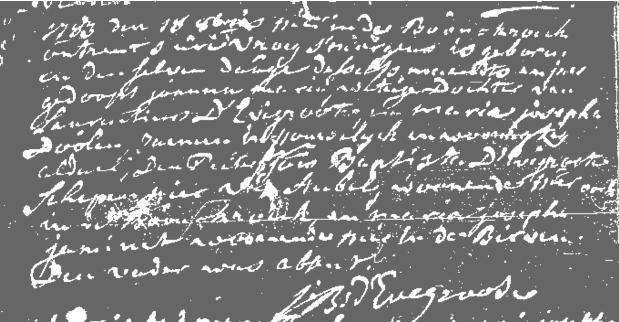 |
| Figure 4. Facsimile of the baptism record of Jeanne d'Evegroote in Aubel on October 18th, 1783. |
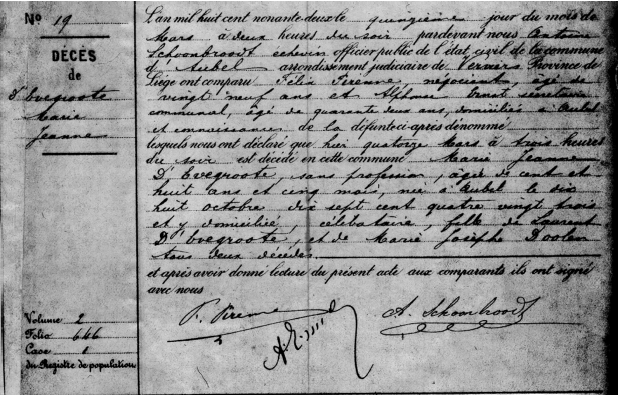 |
| Figure 5. Facsimile of the death record of Jeanne d'Evegroote in Aubel on March 15th, 1892. |
According to Dr. Biraben (1970), the civil registration was established under the French regime with very strict regulations. Statistical tables were requested by all departments
with the annual changes in the population: births, deaths and marriages. A specific table presents the distribution of age at death by sex and yearly age groups. Starting in 1802 (an X) this classification is done every six months and in 1806 the marital status is also considered. In each of these tables, deaths at the age of 100 years and more are reported in the last column of the table with an indication of the exact age at death.
In the Mouvement de la population de la France au cours de l'an XI(4) (ANP F* n°132), we found two persons who died at the age of 103 years in the department of Escaut (Flandre orientale) and one who died at the age of 118 years in the department of Jemappes (Hainaut). One year later, in a similar statistical table, one person died at the age of 100 years in the department of Lys (Flandre occidentale) and two at the age of 101 years in the department of Ourthe (Liège). These three centenarians died in an XI are part of the 41 centenarians who died in the whole French population during the same year.
From 1840 till 1849, statistical tables on age at death by sex and month of death are again available on an annual basis. Annual values are also available through different publications for the period between 1850 and 1886, while, starting in 1886, annual statistics exist at the communal level. Figures 6a and 6b show the development in the number of deaths since 1840 and again gives a clear indication of age exaggeration until 1880.
By comparing the number of centenarians at each census (Table 3) and the number of deaths (Figures 6a and 6b), some checks are possible at an aggregate level. As an example we observe that statistics on age at death give us an average number of 10 centenarians who have died every year between 1846 and 1880 and this number is compatible with a number of about 20 centenarians counted at each census during this period of time. However, this is not an appropriate validation check as it is highly probable that errors in the census and errors when declaring deaths of centenarians may be related and therefore both data sources will overestimate the number of persons aged 100 and more.
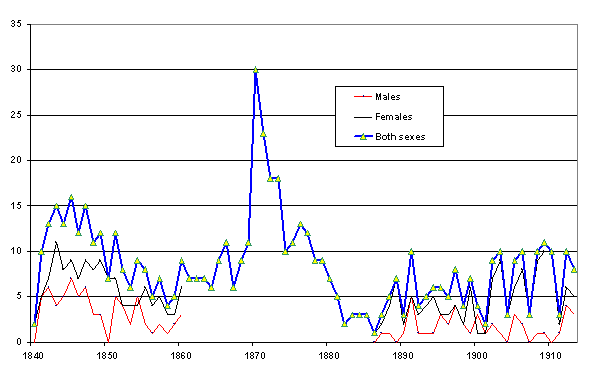 |
| Figure 6a. Number of deaths at the age of 100 and more by year of observation between 1840 and 1913 for both sexes in Belgium. |
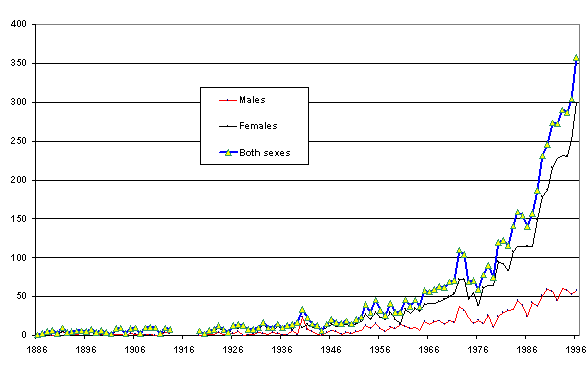 |
| Figure 6b. Number of deaths at the age of 100 and more by year of observation between 1886 and 1996 for both sexes in Belgium. |
As a conclusion this statistical information on age at death is not sufficient to insure the reliability of the age of the centenarians. The only possibility to validate these Belgian centenarians during the XIXth century is an individual and nominative approach by linking death and birth certificates for the same centenarian. This cannot be done in an exhaustive way due to the fact that all centenarians are not known during that period of time. But, starting in 1886, we have the possibility to identify communes where centenarians have died and on this basis to find the corresponding record in the death register and to check the validity of the age by looking at the record of birth or baptism. This work will result in an exhaustive validation of nearly 7,000 Belgian centenarians who have died since 1886 or are still alive.
Introduced in Belgium in 1847 and made statutory in 1857, the population register in Belgium are similar to those in the Nordic countries. As stated in the Royal Act of June 30th 1846, ce registre sera constamment tenu au courant des variations qui surviennent dans la population, par suite des naissances, des décès et des changements de demeure ou de résidence.(5) In fact, as far as demographic variables are concerned, the population register is like a dynamic census permanently updated on a daily basis for the entire population currently living in each commune. These registers are kept at the communal level and are totally renewed with each census so that all changes in the population between two successive censuses may be found in the same population register that may consist of several volumes.
Since 1968 on a voluntary basis and since 1985 on a statutory basis, this population register has been centralised and computerized at the national level. The so-called Registre National contains basic information on more than 13,000,000 individuals with direct access to this information on a national basis according to specific access rules ensuring privacy. The 9 pieces of statutory information included in the Registre National are the following:
| ||||||||||||||||||||||
| ||||||||||||||||||||||
|
Table 4. Development in the total number of centenarians by sex between 1989 and 1997 (Source: INS, Registre National) | ||||||||||||||||||||||||||||||||||||||||||||||||||
| ||||||||||||||||||||||||||||||||||||||||||||||||||
All these pieces of information are dated and the previous information is also displayed as shown for two recent centenarians: Brigitte Hurel and Maurice Baudhuin.
Since 1989, the Registre National reports on a yearly basis the total number of centenarians by sex, and this data presented in Table 4 shows the sharp increase of the number of female centenarians in the last three years and consequently a rapid change of the sex ratio in favour of women.
As it is shown in the case of Maurice Baudhuin, the whole series of population registers since 1890 gives a complete picture of the centenarian biography with all demographic events: birth, parents, marriage, children, moves, widowhood and death. Population registers are definitively the best tools to validate centenarians even if the research through all sets of volumes in different communes often is a tremendous one.
Many others various documents will be helpful to assist in the validation of centenarian data. Among these, newspaper articles and postcards are the more numerous.
In Belgium we have collected about 10,000 articles from newspapers dealing with more than 3,000 centenarians. Nowadays we estimate that 90% of all Flemish or Walloon centenarians may be detected through newspapers while this proportion is relatively lower in the Brussels region (about 70%). However, we can suppose that in the near future this proportion will decrease as the number of centenarians increases sharply (see Table 4).
| ||||||||||||||||||||||||||||||||||||||||||||||||||||||||||||||||||||||||
The photos of Brigitte Hurel (Figures 7a and 7b), who died recently, and the text in the related article give a good example of all qualitative information that can be collected through this type of data source. Most of this information will contribute to validate the centenarian. Here are some sentences extracted from that article:
| Figure 7a. Brigitte Hurel when she was 102 (Vers l'Avenir, n° 184470). |
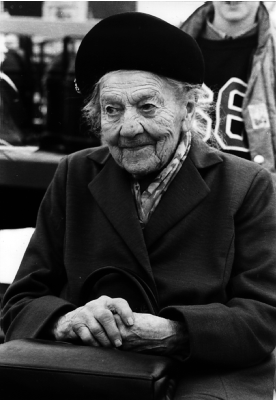 |
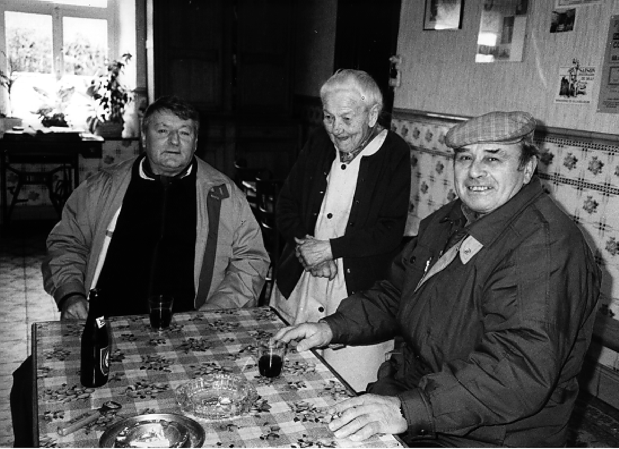 |
| Figure 7b. Brigitte Hurel in her café de Niverlée (Vers l'Avenir, n° 195029). |
Brigitte était née à Niverlée le 4 mai 1891. Quelques années plus tard, ses parents s'installent dans la maison qui fût la sienne plus d'un siècle. Sa maman mourut assez jeune à l'âge de 39 ans. Son père exercait le métier de cordonnier. Brigitte, comme les autres enfants, fréquentait l'école primaire de Mazée, distante d'environ 3 kilomètres que l'on parcourait à pied, bien sûr…(6)
Centenarian postcards were very popular at the end of the last century and during the first decades of the XXth century. Our collection of more than 800 postcards is a unique one and will be very helpful as a piece of validation. Opposite you will find a postcard showing Marie-Adélaïde Quievreux (1808-1909) (Figure 8a) and a photo of her grand-daughter Eugénie Quievreux (1864-1968) (Figure 8b).
Another source of information is the faire-part de décès(7) currently used to announce the death of a person. This document gives some basic demographic information as well as family links. All of these may be useful in identifying and validating centenarians. Figure 9 presents the faire-part de décès de Maria Van Sprengel, the more recent super-centenarian in Belgium, who died in Kontich on April 22nd 1993 at the age of 111.
Based on all the data sources presented in this contribution, the database on Belgian centenarians contains a complete set of information on each centenarian. We intend to complete this database in the near future in order to include all centenarians who have died in Belgium after 1886 or who are still alive. It will be not only a set of validated cases of extreme longevity but also an exhaustive database that will be representative of this extreme longevity among the whole Belgian population during the last century. Using this information, several research projects have already been developed on the force of mortality at 100 years and over, the future number of centenarians in Belgium
and the heritability of longevity (see References). The combination of nominative information with exhaustive administrative data and statistical figures gives us the possibility of new and innovative investigations.
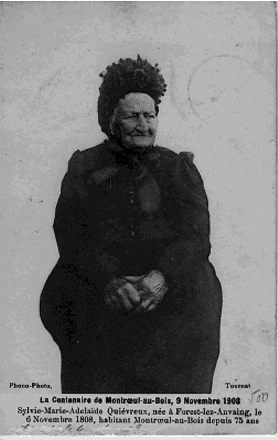 |
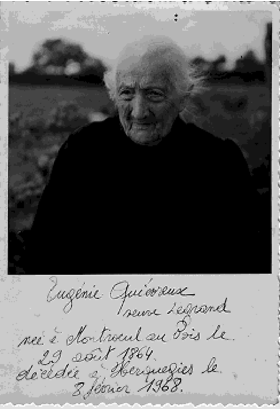 |
| Figure 8a. Postcard showing Marie-Adélaïde Quievreux when she was 100 in 1908 (D. Chambre, personnel collection). |
Figure 8b. Photo of Eugénie Quievreux who died at 104 in 1968. |
| Figure 9. Faire-part de décès of Maria Van Sprengel who died in Kontich on April 22nd 1993 at 111. |
 |
[ Home | Contents | Return to previous page ]
Max-Planck-Gesellschaft 2003